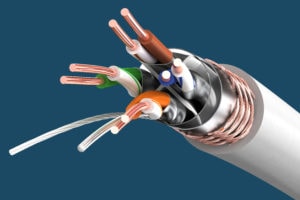
Here we’ll discuss other differences and similarities between thermoplastic and thermoset materials, as well as how they impact the performance of cable jackets.
Cable Jacket Types
Cable jackets protect the conductor core and insulation of cable assemblies from environmental damage. Certain materials suit different levels of protection and applications.
Thermoplastic
Here are the most popular thermoplastic materials for cable jackets.
- Polyvinyl Chloride (PVC): PVC cable jackets can withstand heat, sunlight, weathering, oils, acids, and physical abrasion, making them an excellent choice for outdoor cable jackets.
- Polyurethane: Polyurethane jackets are effective at resisting chemicals and oils. They can also be formulated to resist oxidative damage, ozone, and open flames.
- Chlorinated Polyethylene (CPE): CPE can be formulated in both thermoset and thermoplastic varieties. Thermoplastic CPE can resist heat and flame damage, weather elements, oxidation, and oils.
Thermoset
These are the most common thermoset material options for cable jackets.
- CPE: Compared to thermoplastic CPE, thermoset CPE’s cross-linked structure offers better protection from ozone and ultraviolet damage. When specially formulated, it withstands solvents, bases, and acids as well as long-term water immersion.
- Ethylene Propylene Rubber (EPR): This synthetic rubber is derived from EPR insulation. It can withstand high temperatures as well as temperatures down to -60 °C. EPR can also be designed to resist flames.
- Neoprene: Neoprene is a resilient synthetic rubber that offers good resistance to physical wear, oxidation, sunlight, heat, and cold temperatures. It’s a popular choice for protecting mine trailing cables, dredge cables, and cables in other rugged environments.
Properties of Cable Jackets
Consider which protective properties you need for your cable jackets. Your choice of material will determine which of the following characteristics your cable assembly will have:
- Abrasion resistance
- Chemical resistance
- Deformation resistance
- Flame resistance
- Flexibility and stability at low or high temperatures
- Oil resistance
- Moisture resistance
- Resistance to heat aging
- Weather resistance
By determining which protective characteristics are most important, you can select the best thermoplastic or thermoset cable jacket material to protect your assembly for years to come.
Choose High-Quality Cable Jackets From Connectronics
If you’re ready to select a cable jacket for your particular application, we’re here to help. At Connectronics, we specialize in designing and producing custom, high-performance cable jackets. We manufacture high-voltage and high-current connectors, cable assemblies, wire harnesses, and more. We’re ISO 9001:2015 certified and meet the requirements of AS9100D quality management. Contact us today to learn more about our capabilities, or request a quote to start your custom order.






